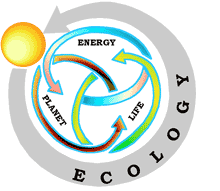
How Does Life Begin and Develop?
Goal
1
How
Life Arose on Earth
Goal
2
Organization of Matter into Living Systems
Goal
4
Coevolution of the Biosphere and the Earth
Does Life Exist Elsewhere in the Universe?
Goal
7
Signature of Life on Other Worlds
Goal
8
Life on Mars and Europa
What is Life's Future on Earth and Beyond?
Goal
9
Environmental Change on Earth
Goal
10
Terrestrial Life in Space
Question: How Does
Life Begin and Develop?
Goal
4: Determine How the Terrestrial Biosphere has
Co-Evolved with the Earth

Trace the coupled evolution of life and the planet by integrating evidence
acquired from molecular biology, studies of present and historical environments,
and research in ecology and organismal biology.
Just as life evolves in response to changing environments, changing ecosystems alter the environment of Earth. Scientists can trace the co-evolution of life and the planet by integrating evidence acquired from studies of current and historical molecular biology (genomics) with studies of present and historical environments and organismal biology. We seek to understand the diversity and distribution of our ancient ancestors by developing increasingly sensitive technology to read the record of life as captured in biomolecules and in rocks (fossils), to identify specific chemical interactions between the living components of the Earth (its biosphere) and other planetary subsystems, and to trace the history of Earth's changing environment in response to external driving forces and to biological modifications.
Background
We need to use the geologic record
to attach dates and environmental context to evolutionary events, leading
to a robust history of the biosphere, based on biomolecular, paleoenvironmental,
and paleobiological evidence. Further, by examining the history of life
in an environmental context and by studying the evolution of biochemical
pathways that yield preservable records (biominerals, accumulations of
trace elements, organic molecules, characteristic fractionations of stable
isotopes, etc.), we can begin to reconstruct the mechanisms that link
environmental and biological changes. Research on these biochemical pathways
will also create an inventory of bio-indicators that may be sought in
ancient rocks on Earth and on other planets. Specific chemical interactions
between the biosphere and its host planet, and their role as evolutionary
drivers, will be illuminated by studies of biogeochemical cycles and significant
biological byproducts, such as molecular oxygen. The development of Earth's
atmosphere will thus be understood in much greater detail, with a new
and more fundamental view of factors controlling its levels of oxygen
and carbon dioxide. Another outcome will be a better understanding of
the evolution of Earth's biosphere. Paleontological evidence for the first
appearances of novel kinds of organisms will be integrated with molecular
phylogenies using quantitative approaches to the fossil record and precise
geochronology. Understanding the full diversity of our evolving biosphere
requires that the fossil records of extreme environments be explored and
documented, an exercise that also has relevance for the search for life
on other worlds. All of this research requires a deeper understanding
of evolutionary mechanisms at the levels of molecules, organisms and ecosystems,
as discussed under Goal 3. The results
contribute directly to the identification of biomarkers (